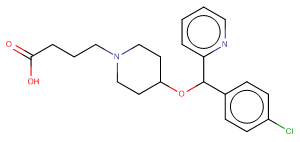
Bepotastine
CAS No. 125602-71-3
Bepotastine ( —— )
Catalog No. M21128 CAS No. 125602-71-3
Bepotastine free base is a histamine 1 (H1) receptor antagonis.
Purity : >98% (HPLC)
 COA
COA
 Datasheet
Datasheet
 HNMR
HNMR
 HPLC
HPLC
 MSDS
MSDS
 Handing Instructions
Handing Instructions
| Size | Price / USD | Stock | Quantity |
| 2MG | 34 | Get Quote |


|
| 5MG | 55 | Get Quote |


|
| 10MG | 87 | Get Quote |


|
| 25MG | 156 | Get Quote |


|
| 50MG | 259 | Get Quote |


|
| 100MG | 389 | Get Quote |


|
| 200MG | 583 | Get Quote |


|
| 500MG | 888 | Get Quote |


|
| 1G | Get Quote | Get Quote |


|
Biological Information
-
Product NameBepotastine
-
NoteResearch use only, not for human use.
-
Brief DescriptionBepotastine free base is a histamine 1 (H1) receptor antagonis.
-
DescriptionBepotastine free base is a histamine 1 (H1) receptor antagonis.
-
In VitroBepotastine (10, 100, 1000 μM; preincubates for 120 min) decreases the release of histamine induced by A23187 treatment, which reaches a statistically significant reduces level at 1000 μM.Bepotastine (50 μM; 1 h) suppresses the expression of NGF mRNA in NHEKs.Cell Viability Assay Cell Line:RPMCs Concentration:10, 100, 1000 μM Incubation Time:120 min (preincubate)Result:Decreased the release of histamine.Western Blot Analysis Cell Line:NHEKs Concentration:50 μM (preincubation)Incubation Time:1 hResult:Suppressed the expression of NGF mRNA in NHEKs.
-
In VivoBepotastine (10 g/L; eye drop; 3 times at intervals of 20 min in one eye) demonstrates significant inhibition of PAF-induced conjunctival eosinophil infiltration.Bepotastine (3 mg/kg; p.o.; once) suppresses scratching behavior to a frequency of 59.0 and a duration of 14.57 seconds, which are almost the same levels compares with the control.Bepotastine (10 mg/kg; p.o.; once) significantly suppresses serum LTB 4 levels to 711.3 pg/mL at 1 h and 858.8 pg/mL at 2 h in NC/Nga mice with a rash. Animal Model:Guinea pigs (6-week-old).Dosage:10 g/L (1.0% (w/v)) for 10 μL.Administration:Eye drop; 3 times at intervals of 20 min (in one eye).Result:Inhibited PAF-induced conjunctival eosinophil infiltration.Animal Model:Male BALB/c mice(12-week-old); NC/Nga mice.Dosage:3, 10 mg/kg Administration:Oral administration; once (1 h before induces scratching behavior of Male BALB/c mice).Result:Significantly inhibited histamine-mediated scratching behavior in male BALB/c mice.Significantly suppressed serum LTB 4 levels in NC/Nga mice with a rash.
-
Synonyms——
-
PathwayOthers
-
TargetOther Targets
-
Recptorothers
-
Research Area——
-
Indication——
Chemical Information
-
CAS Number125602-71-3
-
Formula Weight388.89
-
Molecular FormulaC21H25ClN2O3
-
Purity>98% (HPLC)
-
SolubilityIn Vitro:?DMSO : 100 mg/mL (257.14 mM)
-
SMILESO=C(O)CCCN1CCC(OC(c2ccc(Cl)cc2)c2ccccn2)CC1
-
Chemical Name——
Shipping & Storage Information
-
Storage(-20℃)
-
ShippingWith Ice Pack
-
Stability≥ 2 years
Reference
1.Kanzaki S Hashiguchi K Wakabayashi K I et al. Histamine antagonist Bepotastine suppresses nasal symptoms caused by Japanese cedar and cypress pollen exposure[J]. journal of drug assessment 2016 5(1):15-23.
molnova catalog



related products
-
Methyl syringate
Methyl syringate has a unique inhibitory activity toward aflatoxin production with a different mode of action from that of gallic acid.
-
Vardenafil hydrochlo...
Vardenafil HCl Trihydrate is a new type PDE inhibitor with IC50 of 0.7 and 180 nM for PDE5 and PDE1, respectively.
-
Intermedin (rat)
Intermedin (rat) is a polypeptide that can be found by peptide screening. Peptide screening is a research tool that pools active peptides primarily by immunoassay. Peptide screening can be used for protein interaction, functional analysis, epitope screening, especially in the field of agent research and development.



 Cart
Cart
 sales@molnova.com
sales@molnova.com


